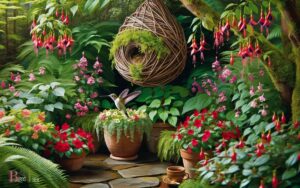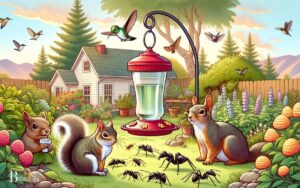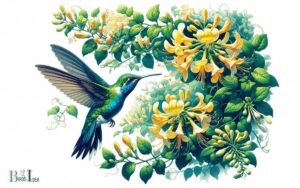Are Hummingbirds Attracted to Lilac Bushes? Discover!
Hummingbirds are generally attracted to brightly colored flowers, especially those with tubular shapes that accommodate their long bills.
Lilac bushes, while not a top choice for hummingbirds, may still attract them if they have other suitable features.
Lilac blooms are often fragrant and come in vibrant colors, which can catch the attention of hummingbirds. However, these birds are more commonly drawn to red, pink, or orange flowers.
If your lilac bushes have these colors and are in close proximity to other hummingbird-friendly plants, there’s a chance they may visit.
Ultimately, incorporating a variety of hummingbird-friendly flowers in your garden is the best way to attract these delightful creatures.

Key Takeaway
The Characteristics of Lilac Bushes
One can easily recognize lilac bushes by their fragrant flowers and heart-shaped leaves. These deciduous shrubs belong to the olive family and are known for their stunning clusters of blossoms that come in various shades of purple, pink, white, and lavender.
The flowers emit a sweet, pleasant fragrance that attracts not only humans but also pollinators like butterflies and bees.
Lilac bushes are relatively low maintenance and can thrive in a variety of soil types, making them a popular choice for home gardens.
They typically bloom in the spring and can add a pop of color and a delightful aroma to any outdoor space.
Additionally, lilac bushes are known for their hardiness and ability to withstand harsh weather conditions, making them a resilient and attractive option for landscaping.
Hummingbird Feeding Habits
Attracted to nectar-rich flowers, hummingbirds feed throughout the day to fuel their high metabolism and sustain their rapid wing beats.
These tiny birds have fascinating feeding habits that are essential to their survival and energy needs.
Here are some key points to understand their feeding behavior:
- Hummingbirds consume half their weight in nectar daily.
- They also feed on small insects and spiders for protein.
- Their long, specialized bills allow them to reach deep into flowers for nectar.
- Hummingbirds have a remarkable memory for the locations of individual flowers, enabling efficient feeding routes.
Understanding these feeding habits sheds light on why certain flowers, such as lilac bushes, may attract hummingbirds due to their nectar-producing blooms and the insects they attract.
Nectar Availability in Lilac Bushes
The lilac bushes provide nectar that is easily accessible to hummingbirds due to their tubular flowers.
These flowers have a shape that allows hummingbirds to insert their long, slender bills and tongues to reach the sweet nectar hidden within.
The nectar within lilac flowers is an enticing food source for hummingbirds, as it provides them with the energy they need for their active lifestyle.
The abundance of nectar in lilac bushes makes them an attractive option for hummingbirds seeking nourishment.
Furthermore, the high sugar content of the nectar in lilac flowers makes it a valuable food source for these energetic birds.
This nectar availability plays a significant role in attracting hummingbirds to lilac bushes. This nectar availability sets the stage for the subsequent discussion on lilac bush color and attraction.
Lilac Bush Color and Attraction
Lilac bushes with vibrant, saturated blossoms are particularly appealing to hummingbirds due to their heightened visibility and attractiveness.
Hummingbirds are attracted to a variety of colors, but they are especially drawn to certain shades of lilac, including purple, magenta, and deep pink.
The following characteristics make lilac bushes of these colors stand out to hummingbirds:
- Brightness: The vivid coloration of lilac blossoms catches the attention of hummingbirds.
- Contrast: Lilac hues contrast sharply with green foliage, making them easier for hummingbirds to spot.
- Long-distance visibility: The saturated tones of certain lilac varieties are visible from a distance, guiding hummingbirds to potential nectar sources.
- Attractive patterns: Some lilac varieties exhibit attractive patterns or markings that further entice hummingbirds.
These factors make lilac bushes with vibrant, saturated blossoms particularly appealing to hummingbirds.
Lilac Bush Placement in the Garden
When considering the placement of lilac bushes in the garden, it’s important to ensure they receive optimal sunlight, as this directly impacts their growth and blooming.
Additionally, paying attention to soil and drainage requirements is crucial for the health and longevity of the lilac bushes.
Moreover, selecting companion plants that complement and support the growth of lilacs can enhance the overall garden aesthetic and ecological balance.
Optimal Sunlight for Lilacs
Placing lilac bushes in a location with full sunlight is crucial for their optimal growth and blooming. Lilacs require adequate sunlight to thrive and produce an abundance of beautiful blooms.
When considering the placement of lilac bushes in the garden, it’s important to keep the following factors in mind:
- Sun Exposure: Lilac bushes should ideally be placed in an area that receives at least 6-8 hours of direct sunlight daily.
- Air Circulation: Choose a location with good air circulation to prevent diseases and promote overall plant health.
- Soil Drainage: Ensure that the planting site has well-draining soil to prevent waterlogging, which can be detrimental to lilac bushes.
- Spacing: Provide enough space between lilac bushes and other plants to allow for proper air circulation and prevent overcrowding.
Soil and Drainage Requirements
To ensure optimal growth and blooming of lilac bushes, it is essential to consider the soil and drainage requirements for their placement in the garden.
Lilacs thrive in well-draining, slightly alkaline soil with a pH range of 6.5 to 7.5. They prefer loamy soil that is rich in organic matter and provides good drainage to prevent waterlogging, which can lead to root rot.
Adding compost or well-rotted manure to the soil before planting can improve its structure and nutrient content.
Additionally, proper drainage is crucial to prevent water from pooling around the roots, which can also cause damage.
The following table summarizes the soil and drainage requirements for planting lilac bushes in the garden:
| Soil and Drainage Requirements | Description |
|---|---|
| Soil pH | 6.5 to 7.5 |
| Soil Type | Well-draining loamy soil rich in organic matter |
| Drainage | Good drainage to prevent waterlogging and root rot |
Companion Plants for Lilacs
Positioned near lilac bushes, companion plants can enhance the overall beauty and health of the garden space.
Choosing the right companion plants can help attract pollinators, repel pests, and provide a visually appealing contrast to the lilac blooms.
When selecting companion plants for lilacs, consider plants that have similar soil and light requirements to ensure they thrive together.
Some suitable companion plants for lilacs include:
- Peonies: Their lush foliage and large, showy blooms complement the delicate lilac flowers.
- Catmint: This aromatic herb attracts pollinators and deters pests while adding a pop of color.
- Daylilies: With their vibrant blooms and grass-like foliage, they create a stunning contrast next to lilac bushes.
- Lavender: This fragrant herb not only complements the scent of lilacs but also attracts beneficial insects.
Other Plants to Attract Hummingbirds
Hummingbirds are also attracted to a variety of other plants in addition to lilac bushes. They are particularly drawn to trumpet-shaped flowers such as bee balm, columbine, and penstemon.
These plants produce nectar that is irresistible to hummingbirds. Additionally, they are attracted to bright and vivid colors, so incorporating plants like salvia, fuchsia, and cardinal flower can entice them to visit your garden.
It’s important to have a mix of plants that bloom at different times throughout the growing season to provide a consistent nectar source for hummingbirds.
By planting a diverse selection of nectar-rich flowers, gardeners can create an inviting environment for these enchanting birds.
Benefits of Hummingbirds in the Garden
When considering the benefits of having hummingbirds in the garden, it’s evident that they play a crucial role in pollination and fostering a healthy ecosystem.
- Hummingbirds are efficient pollinators, aiding in the reproduction of various plants.
- Their presence can lead to an increase in the diversity and abundance of flowering plants in the garden.
- Hummingbirds help control insect populations by consuming large numbers of pests like aphids and spiders.
- Their graceful presence adds beauty and enchantment to the garden, enhancing the overall ambiance.
These benefits highlight the significance of attracting and supporting hummingbirds in a garden setting.
Tips for Creating a Hummingbird-Friendly Garden
An essential element for creating a hummingbird-friendly garden is to incorporate a variety of nectar-producing flowers and shrubs.
Hummingbirds are attracted to bright, tubular flowers such as trumpet vine, bee balm, and salvia.
It’s important to choose a range of flowers that bloom at different times throughout the year to ensure a consistent nectar supply.
Additionally, including flowering shrubs like weigela, butterfly bush, and honeysuckle can provide a longer-term nectar source for hummingbirds.
Another tip is to incorporate a water feature, such as a shallow birdbath or a mister, to provide drinking and bathing opportunities for hummingbirds.
It’s also beneficial to minimize or eliminate pesticide use in the garden to create a safe environment for these delicate birds.
By following these tips, gardeners can attract and support hummingbirds in their outdoor spaces.
Conclusion
Lilac bushes are indeed attractive to hummingbirds due to their abundant nectar and vibrant colors. By planting lilac bushes and other nectar-rich plants, gardeners can create a beautiful oasis for these enchanting birds.
Like a colorful dance floor in a bustling nightclub, the garden becomes a lively stage for hummingbirds to flit and feed, bringing joy and beauty to any outdoor space.






